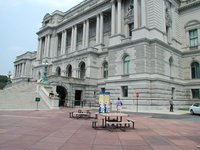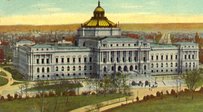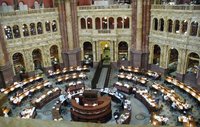Library of Congress
|
|
The Library of Congress is the unofficial national library of the United States. With over 128 million items, it is one of the largest libraries in the history of the world, surpassed only by the British Library, which contains over 150 million items. With over 530 miles of shelves, the Library of Congress certainly is the longest library in the world. Its collections include more than 28 million cataloged books and other print materials in 470 languages; more than 50 million manuscripts; the largest rare book collection in North America, including a Gutenberg Bible; and the world's largest collection of legal materials, films, maps, sheet music and sound recordings.
The Library of Congress was established on April 24 1800, when President John Adams signed an act of Congress providing for the transfer of the seat of government from Philadelphia to the new capital city of Washington. The legislation appropriated $5,000 "for the purchase of such books as may be necessary for the use of Congress ..., and for fitting up a suitable apartment for containing them...." The original library was housed in the new Capitol until August 1814, when invading British troops set fire to the Capitol building, destroying the contents of the small (3,000 volumes) library.
Within a month, retired President Thomas Jefferson offered his personal library as a replacement. Jefferson had spent 50 years accumulating books, "putting by everything which related to America, and indeed whatever was rare and valuable in every science"; his library was considered to be one of the finest in the United States. Jefferson, who was heavily indebted, sought to use the proceeds of the sale of his books to satisfy his creditors. He anticipated controversy over the nature of his collection, which included books in foreign languages and volumes of philosophy, science, literature, and other topics not normally viewed as part of a legislative library. He wrote, "I do not know that it contains any branch of science which Congress would wish to exclude from their collection; there is, in fact, no subject to which a Member of Congress may not have occasion to refer."
In January 1815, Congress accepted Jefferson's offer, appropriating $23,950 for his 6,487 books, and the foundation was laid for a great national library. The Jeffersonian concept of universality, the belief that all subjects are important to the library of the American legislature, is the philosophy and rationale behind the comprehensive collecting policies of today's Library of Congress.
The Library is now spread over three buildings in Washington, D.C.:
- The Thomas Jefferson Building (between Independence Avenue and East Capitol Street on First Street SE), opened in 1897, and long the main building of the Library;
- The John Adams Building (between Independence Avenue and East Capitol Street on 2nd Street SE), opened as an annex in 1938; and
- The James Madison Memorial Building (between First and Second Streets on Independence Avenue SE), opened in 1981 as the new headquarters of the Library.
The Library also developed a system of book classification called Library of Congress classification (LC) which is used by most research and university libraries, although most public libraries continue to use the Dewey decimal system.
The library is open to the general public for academic research, and runs tours for visitors. Only those who are issued a Reader Identification Card may enter the reading rooms and access the collection. The Reader Identifcation Card is available in the Madison building to persons who are over 18 years of age upon presentation of a government issued picture identification (e.g., driver's license, State ID card, Passport). However, only members of Congress, their staff and certain other government officials can actually check out books.
The Library serves as a legal repository to guarantee copyright protection. All authors seeking American copyright registration are required to submit two copies of their works to the Library. Largely due to this provision of the copyright law, nearly 22,000 new items published in the U.S. arrive every business day at the Library. Contrary to popular belief, however, the Library does not retain all of these works in its permanent collection, although it does add an average of 10,000 items per day.
It is estimated that the print holdings of the Library of Congress would, if digitized and stored as plain text, constitute 17 to 20 terabytes of information. This leads to the commonly-repeated but misleading equivalence of 20 terabytes to the entire holdings of the Library. Occasionally, this figure has been referred to as a data transfer rate, LoCs/s- Libraries of Congress per Second- and equates to 20 terabytes of data transferred per second, even though the 20 terabyte estimation is misleading. Only selected portions of the print holdings have actually been digitized, and the Library currently has no plans for systematic digitization of any significant portion of its books. The Library makes millions of digital objects, comprising tens of terabytes, available at its American Memory site. American Memory is a source for public domain image resources, as well as audio, video, and archived Web content. Nearly all of the lists of holdings, the catalogs of the library, can be consulted directly on its web site. Librarians all over the world consult these catalogs, through the Web or through other media better suited to their needs, when they need to catalog for their collection a book published in the United States. They use the Library of Congress Control Number to make sure of the exact identity of the book.
The Library of Congress also provides an on-line archive of the proceedings of the U.S. Congress at Thomas (http://thomas.loc.gov), including bill text, Congressional Record text, bill summary and status, the Congressional Record Index, and the United States Constitution.
The Library also administers the National Library Service for the Blind and Physically Handicapped, a talking and braille library program provided to more than 766,000 Americans.
Librarians of Congress
The head of the Library of Congress is called the Librarian of Congress. The list of past Librarians of Congress includes several notable figures:
- John James Beckley (1802–1807)
- Patrick Magruder (1807–1815)
- George Watterston (1815–1829)
- John Silva Meehan (1829–1861)
- John Gould Stephenson (1861–1864)
- Ainsworth Rand Spofford (1864–1897)
- John Russell Young (1897–1899)
- Herbert Putnam (1899–1939)
- Archibald MacLeish (1939–1944)
- Luther H. Evans (1945–1953)
- Lawrence Quincy Mumford (1954–1974)
- Daniel J. Boorstin (1975–1987)
- James H. Billington (1987–)
LibCongressCommem2000.jpg
See also
- Library of Congress Country Studies
- Congressional Research Service
- Poet Laureate Consultant in Poetry to the Library of Congress
- Library of Congress Living Legend
- Library of Congress Classification
- United States Copyright Office
External links
- The Library of Congress website (http://www.loc.gov/)
- History of the Library of Congress (http://www.loc.gov/loc/legacy/)
- American Memory (http://memory.loc.gov/)
- thomas.loc.gov, legislative informationde:Library of Congress
es:Biblioteca del Congreso (EE.UU.) fr:Bibliothèque du Congrès he:ספריית הקונגרס nl:Library of Congress pl:Biblioteka Kongresu Stanów Zjednoczonych pt:Biblioteca do Congresso zh:美国国会图书馆



